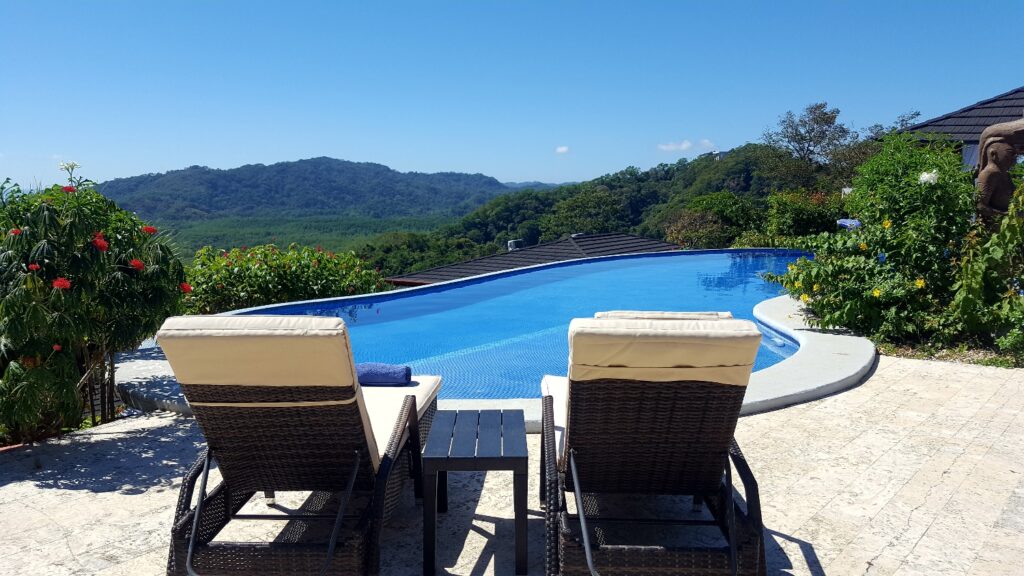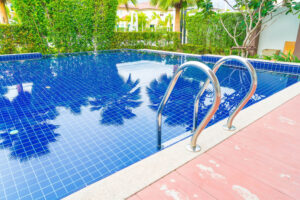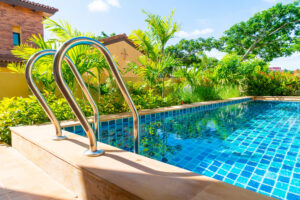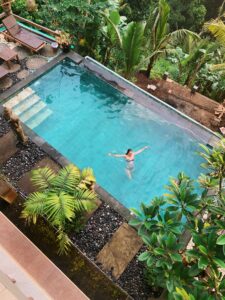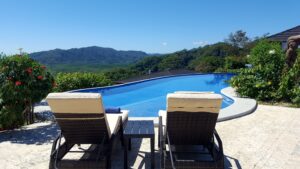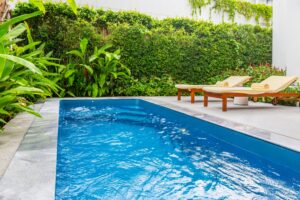A plunge pool for sloped backyard might seem like a challenge for installing a pool, but it can actually become your property’s most stunning feature. Plunge pools are ideal solutions for steep terrain, requiring less space while providing all the benefits of a traditional swimming pool.
By cutting into the hillside and using proper retaining walls, you can transform your challenging slope into a secluded water retreat that feels like a natural part of the landscape.
Many homeowners don’t realize that slopes offer unique design opportunities that flat yards simply can’t match. With a thoughtfully designed plunge pool, you can create multi-level entertaining areas, incorporate natural elements like rock formations, or even design an infinity edge that makes your pool appear to merge with the horizon beyond. These designs don’t just work around your terrain – they celebrate it.
We’ve seen countless sloped properties transformed with small, structurally sound plunge pools that become the centerpiece of outdoor living spaces.
Options like asymmetrical designs, solar lighting, and integrated planters can enhance your pool’s appeal while working harmoniously with the natural contours of your yard. The result is a customized retreat that turns what was once considered a landscape liability into your property’s most valuable asset.
In this article, you’ll learn how to design and install a plunge pool for a sloped backyard, turning uneven terrain into a stylish and functional retreat:
Let’s break down the key points you should consider when building a small pool on a hill or challenging slope.
Why sloped backyards are ideal for plunge pools
Sloped backyards offer unique advantages that make them perfect for plunge pool installation. The natural terrain creates opportunities for stunning designs while solving practical challenges that flat yards simply can’t match.
Natural elevation equals built-in design appeal
A sloped backyard naturally creates visual interest for your plunge pool. The elevation differences allow for dramatic designs like infinity edges where water appears to flow endlessly into the horizon.
We can incorporate the slope into a multi-level design with the pool as a centerpiece. This built-in elevation means your plunge pool can be positioned to capture the best views of your property or beyond.
The height variations also create natural privacy zones around your pool area. With strategic positioning, we can ensure your plunge pool becomes a secluded retreat rather than being visible to neighbors or from the street.
Gravity drainage and hydro flow advantages
Sloped terrain provides excellent natural drainage benefits for your plunge pool. Water naturally flows downhill, which we can harness for more efficient pool systems.
The natural gradient makes it easier to install drainage systems that prevent water accumulation around your pool. This reduces potential damage to your property during heavy rains or when emptying the pool for maintenance.
We can use gravity to our advantage for water features too. Waterfalls, cascades, and streams can flow naturally down the slope into your plunge pool, creating stunning visual and audio elements without requiring powerful pumps.
The natural water flow also helps with pool circulation, potentially reducing energy costs for your filtration system.
Why plunge pools adapt better than large in-ground pools
Plunge pools are smaller and more flexible in design than traditional pools, making them ideal for challenging slopes. Their compact size requires less excavation and fewer retaining walls, reducing construction costs significantly.
We can position plunge pools to work with the natural terrain rather than fighting against it. Models like the WaterWell® pool mentioned in search results are specifically designed for sloped yards.
The smaller water volume makes maintenance more manageable and affordable on a slope. Heating is more efficient too, as less water means faster warming and lower energy bills.
On sloped properties where heating efficiency matters, covering your pool when not in use can reduce evaporation and heat loss by up to 70%, while pairing it with an ENERGY STAR variable-speed pump can cut yearly energy use by around 65%, saving over $400 annually, according to the Energy Gov.
Plunge pools can be partially above-ground on the downhill side, creating an attractive feature while minimizing the need for extensive earthmoving that larger pools would require.
Design ideas for installing a plunge pool on a slope
Working with a sloped backyard requires strategic design approaches that transform challenging terrain into an asset. A well-planned plunge pool can actually benefit from the natural elevation changes in your yard.
Tiered patios and retaining walls
Retaining walls are essential elements when installing a plunge pool on sloped terrain. These structures hold back soil and create level areas for your pool installation.
We recommend using materials that complement your home’s exterior, such as natural stone, concrete blocks, or timber. The height of your retaining wall will depend on the degree of slope in your yard.
Tiered patios work wonderfully with sloped properties, creating multiple levels that add visual interest. The upper level can serve as a lounging area while the lower level hosts your plunge pool.
This design approach allows for easier access to the pool while maximizing your available space. Consider adding built-in seating along the retaining walls to create a cohesive outdoor living area.
Semi-inground installation for stability and style
A semi-inground installation takes advantage of the natural slope by building the pool into the hillside. This design is partially buried on the uphill side while exposed on the downhill side.
This approach saves on excavation costs since you won’t need to dig out the entire pool area. It also provides excellent stability on sloped terrain.
The exposed side of your plunge pool can be finished with decorative materials like stone veneer or wood paneling. This creates a striking visual element in your landscape.
Semi-inground pools also offer easier access on the downhill side, where you might install steps or a small deck. This installation type works particularly well when there’s an 8-foot or greater elevation change across your property.
According to Energy Star, Choosing energy-efficient upgrades—like a pool cover and a variable-speed pump—not only enhances performance but also lowers your long-term operating expenses.
Deck-level pools with hillside views
Elevated deck-level plunge pools maximize the panoramic views that often come with sloped properties. A raised wooden or composite deck creates a level surface for your pool while showcasing the surrounding landscape.
We find that this design works especially well when your main living area is on the upper portion of the slope. The deck creates a seamless transition between indoor and outdoor spaces.
Railings can be designed to minimize obstruction of views while maintaining safety. Consider glass panels or thin cable systems that meet code requirements without blocking sightlines.
A deck-level pool also allows for creative lighting underneath, creating a floating effect at night. This design is particularly stunning for evening entertaining and adds value to your outdoor living space.
Integrating plunge pools into terraced landscaping
Terraced landscaping offers the perfect solution for installing a plunge pool on sloped terrain. By creating multiple flat levels on your hillside, you can transform challenging topography into a functional and beautiful outdoor space.
We recommend starting with a professional assessment of your slope’s grade. This helps determine how many terraces you’ll need and where your plunge pool will fit most naturally.
Retaining walls are essential elements in terraced designs. Options include:
- Natural stone walls (best for rustic settings)
- Concrete blocks (affordable and versatile)
- Timber (warm aesthetic but requires maintenance)
The plunge pool typically works best on the lowest or middle terrace. This placement allows for easier access while creating visual interest as you move through the landscape.
Consider drainage carefully when planning your terraced pool area. Each level should gently slope away from structures while directing water to appropriate drainage systems.
Steps or pathways between terraces add functionality and visual appeal. We suggest using materials that complement your retaining walls for a cohesive look.
Plantings around the terraces soften the hardscape elements. Drought-tolerant options work well since slopes often drain quickly. Try ornamental grasses, succulents, or cascading plants that spill over retaining walls.
Lighting is another important element for terraced pool areas. Path lights, wall-mounted fixtures, and underwater pool lights create a magical atmosphere for evening enjoyment.
Structural tips for building on uneven ground
Building a plunge pool on sloped terrain requires careful planning and specific construction techniques. The right approach transforms challenging landscapes into stunning pool areas while ensuring safety and longevity.
Excavation and soil analysis essentials
Before any construction begins, proper soil testing is critical. We recommend conducting a complete geotechnical survey to understand soil composition and stability on your sloped property.
Different soil types respond differently to weight and water pressure. Clay soils expand when wet and contract when dry, while sandy soils may shift more easily.
Professional soil analysis typically costs $500-1,500 but saves thousands in potential repairs later. This analysis determines:
- Load-bearing capacity
- Soil composition
- Water table levels
- Potential erosion risks
Proper excavation on a slope often requires bench-cutting the hillside in tiers rather than creating one steep cut. This method improves stability and creates a more natural-looking finished product.
When you need a retaining wall (and when you don’t)
Retaining walls are essential when your slope exceeds a 7° grade. They provide structural support and prevent soil erosion around your plunge pool.
When you need a retaining wall:
- Slopes steeper than 7°
- Loose or sandy soil conditions
- Areas with heavy rainfall
- When the pool is near the top of a slope
When you might not need one:
- Gentle slopes under 7°
- Solid bedrock foundations
- Terraced designs with multiple smaller walls
- Some fully above-ground installations
Quality retaining walls require proper drainage behind them. We always include weep holes and gravel backfill to prevent water pressure buildup.
For aesthetic appeal, consider materials like natural stone, concrete blocks, or timber that complement your pool design while providing necessary support.
Foundation options: Poured concrete vs modular shells
The foundation choice significantly impacts your plunge pool’s longevity on sloped terrain.
Poured concrete foundations offer superior customization and strength for uneven ground. They can be shaped to follow natural contours and provide excellent stability. However, they typically cost 15-25% more than modular options and require longer installation time.
Modular shell systems come pre-manufactured and can be installed more quickly. They work well on moderate slopes but may require more extensive site preparation to create a level base.
Key considerations for foundations:
- Concrete thickness should increase from 4″ to 6″ minimum on slopes
- Steel reinforcement is essential (typically #3 or #4 rebar in a grid pattern)
- Proper curing time must be allowed before further construction
We recommend poured concrete for slopes exceeding 15° due to its superior structural integrity.
Drainage considerations to avoid runoff issues
Proper drainage is critical when installing plunge pools on slopes to prevent erosion and structural damage.
A comprehensive drainage system should include:
- French drains around the pool perimeter
- Surface grading that directs water away from structures
- Catch basins at strategic points to collect runoff
- Permeable materials for surrounding decking where possible
Water always finds the path of least resistance downhill. Without proper drainage, your beautiful pool area can quickly become damaged during heavy rains.
Consider installing a dedicated sump pump system for areas with significant water flow. These systems can automatically redirect water away from your pool structure.
Strategically placed vegetation around your pool area also helps control erosion while enhancing the natural aesthetic of your sloped backyard retreat.
Little Dipper Plunge Pools: Engineered for any terrain
Little Dipper plunge pools are specifically designed to overcome the challenges of difficult landscapes, including sloped backyards. These precast concrete pools combine durability with flexible installation options that work with your terrain, not against it.
Lightweight shells for faster install on slopes
Little Dipper pools feature innovative precast concrete shells that are significantly lighter than traditional gunite or poured concrete options. This lightweight design makes them ideal for sloped yards where heavy equipment access might be limited.
The shells arrive as a single piece, reducing installation time from months to just days. This is especially valuable on slopes where prolonged construction could lead to erosion or drainage issues.
We reinforce all shells with specialized structural supports that prevent shifting or settling on uneven ground. This engineering ensures your pool remains stable even when installed on a hillside or variable terrain.
Each shell includes pre-designed anchoring points that secure the pool to your slope, preventing movement during seasonal ground shifts or after heavy rainfall.
Low-maintenance finishes built for exposed terrain
Sloped yards often experience more direct sun exposure and runoff than flat properties. Little Dipper pools address this with UV-resistant finishes that won’t fade or deteriorate under intense sunlight.
Our proprietary concrete blend resists staining from soil runoff that commonly affects pools on hillsides. This means less time scrubbing and more time enjoying your pool.
The non-porous surface prevents water absorption and reduces the risk of cracks from freeze-thaw cycles, a common concern for exposed pool installations.
We incorporate built-in drainage channels around the pool perimeter to manage water flow on sloped yards, protecting both your pool and property from erosion damage.
How to get a free site evaluation for your yard
We offer complimentary site evaluations to assess your sloped yard’s specific challenges and opportunities. Our team measures exact slope angles and soil conditions to determine the optimal pool placement.
Scheduling is simple—visit our website or call to book a convenient time. Most evaluations take less than an hour to complete.
During the evaluation, we’ll discuss potential designs that maximize your view while minimizing excavation needs. We’ll also identify any necessary retaining features or drainage solutions.
You’ll receive a detailed report including installation timeline, terrain-specific recommendations, and exact cost estimates with no hidden fees. This transparent approach ensures you understand exactly what’s involved in transforming your sloped yard.
Conclusion
Plunge pools offer an excellent solution for homeowners with sloped backyards. They transform challenging terrain into beautiful retreats that enhance both property value and lifestyle quality.
These compact pools require less water, maintenance, and space than traditional swimming pools. This makes them ideal for hillside properties where extensive grading would be costly.
Working with the natural slope creates opportunities for unique design elements like infinity edges or multi-level terraces. These features turn what might have been a limitation into a stunning visual advantage.
Professional help is crucial for addressing drainage, structural support, and retaining wall requirements. While the initial investment might be higher than a flat-yard installation, the results can be truly spectacular.
We believe plunge pools on slopes offer the perfect balance of practicality and luxury. They provide refreshing relief on hot days while serving as a focal point for outdoor entertaining.
With thoughtful planning and design, your sloped backyard can become your favorite destination—a personal oasis that celebrates rather than fights against your property’s natural topography.
Schedule a free site evaluation with Little Dipper Pools to explore plunge pool options tailored to your sloped backyard layout.

